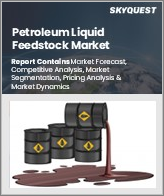
석유 액체 원료 세계 시장 규모는 2023년에 3,143억 달러로 평가되었으며, 2024년 3,319억 달러에서 2032년에는 5,132억 4,000만 달러로 성장하고, 예측 기간(2025-2032년) 동안 CAGR 5.6%로 성장할 전망입니다.
세계 석유 액체 원료 시장은 석유화학 부문의 수요 증가, 정제 공정의 혁신, 지속가능성에 대한 높은 관심으로 인해 눈에 띄게 성장하고 있습니다. 탄소 중립 석유화학제품 생산을 위한 자금 지원과 함께 각국 정부의 R&D 이니셔티브에 대한 지원도 주목할 만합니다. 바이오 기반 정제, 폐쇄 루프 재활용, 수소 연료 공정에 종사하는 기업들은 유리한 규제의 혜택을 받아 투자를 유치하고 지속가능한 선택에 대한 소비자의 수요를 충족시킬 가능성이 높습니다. 그러나 시장은 원유 가격 변동, 공급망 붕괴, 정제업체들이 더 깨끗하고 유연한 기술을 채택하도록 강요하는 강화된 환경 규제와 같은 장애물에 직면해 있습니다. 전반적으로, 이러한 도전과 진화하는 시장 역학 속에서도 전망은 여전히 밝습니다.
Global Petroleum Liquid Feedstock Market size was valued at USD 314.3 billion in 2023 and is poised to grow from USD 331.9 billion in 2024 to USD 513.24 billion by 2032, growing at a CAGR of 5.6% during the forecast period (2025-2032).
The global petroleum liquid feedstock market is experiencing notable expansion, driven by heightened demand from the petrochemical sector, innovations in refining processes, and a strong focus on sustainability. Support from governments for research and development initiatives, alongside funding for carbon-neutral petrochemical production, is notable. Companies engaged in bio-based refining, closed-loop recycling, and hydrogen-fueled processes are likely to benefit from favorable regulations, attracting investment and fulfilling consumer demand for sustainable options. However, the market confronts obstacles such as fluctuations in crude oil prices, disruptions in supply chains, and increasingly strict environmental regulations, which press refiners to adopt cleaner and more flexible technologies. Overall, the outlook remains positive amid these challenges and evolving market dynamics.
Top-down and bottom-up approaches were used to estimate and validate the size of the Global Petroleum Liquid Feedstock market and to estimate the size of various other dependent submarkets. The research methodology used to estimate the market size includes the following details: The key players in the market were identified through secondary research, and their market shares in the respective regions were determined through primary and secondary research. This entire procedure includes the study of the annual and financial reports of the top market players and extensive interviews for key insights from industry leaders such as CEOs, VPs, directors, and marketing executives. All percentage shares split, and breakdowns were determined using secondary sources and verified through Primary sources. All possible parameters that affect the markets covered in this research study have been accounted for, viewed in extensive detail, verified through primary research, and analyzed to get the final quantitative and qualitative data.
Global Petroleum Liquid Feedstock Market Segments Analysis
Global Petroleum Liquid Feedstock Market is segmented by Type, End Product and region. Based on Type, the market is segmented into Naphtha and Gas Oil. Based on End Product, the market is segmented into Ethylene, Benzene, Propylene, Hexane, Naphthalene and Others. Based on region, the market is segmented into North America, Europe, Asia Pacific, Latin America and Middle East & Africa.
Driver of the Global Petroleum Liquid Feedstock Market
The petroleum liquid feedstock market is being actively propelled by the continuous increase in global energy demand, especially within emerging economies. As industrialization and urbanization progress, the consumption of refined petroleum products such as gasoline, diesel, and jet fuel is on the rise. This surge in energy requirements is stimulating greater investments in refining infrastructure, as companies strive to ensure a consistent and reliable supply of feedstock for their production processes. Consequently, the dynamics of this market are heavily influenced by these factors, highlighting the importance of adapting to evolving energy needs and optimizing refinery operations.
Restraints in the Global Petroleum Liquid Feedstock Market
One of the primary challenges facing the global petroleum liquid feedstock market is the volatility in oil prices. Fluctuations, influenced by geopolitical tensions, OPEC's strategic decisions, and shifts in supply-demand dynamics, complicate profit margin stability for companies. This unpredictability presents significant hurdles for refineries and other stakeholders, as they are tasked with navigating an unstable market, which can result in delays or necessary adjustments in their feedstock procurement and refining processes. Consequently, maintaining operational efficiency and financial performance becomes increasingly difficult in such an unpredictable environment.
Market Trends of the Global Petroleum Liquid Feedstock Market
The Global Petroleum Liquid Feedstock market is witnessing a notable trend towards the adoption of advanced refining technologies, driven by the need for increased operational efficiency and compliance with stringent environmental regulations. Innovations such as hydrocracking, hydrotreating, and catalytic cracking are gaining traction, allowing refiners to enhance the quality of end products while minimizing impurities. This shift not only boosts refinery output but also aligns with global sustainability goals by reducing harmful emissions. As oil companies invest in these cutting-edge technologies, the market is expected to evolve, with a greater emphasis on eco-friendly practices and sustainable production methodologies in response to consumer and regulatory demands.